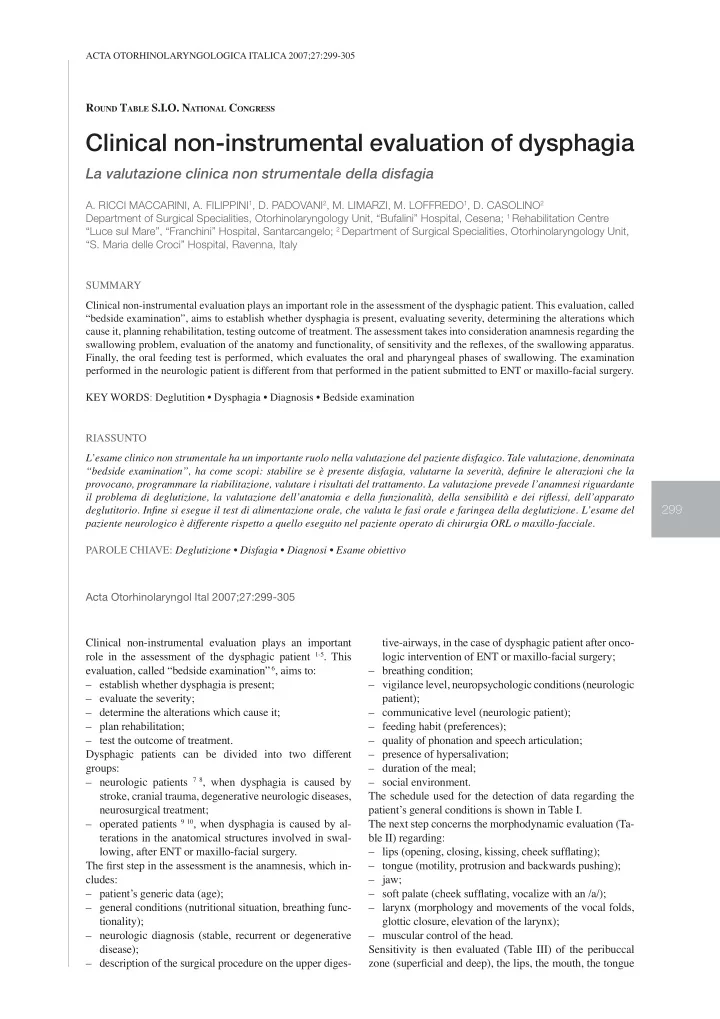

ACTA OTORHINOLARYNGOLOGICA ITALICA 2007;27:299-305 R OUND T ABLE S.I.O. N ATIONAL C ONGRESS Clinical non-instrumental evaluation of dysphagia La valutazione clinica non strumentale della disfagia A. RICCI MACCARINI, A. FILIPPINI 1 , D. PADOVANI 2 , M. LIMARZI, M. LOFFREDO 1 , D. CASOLINO 2 Department of Surgical Specialities, Otorhinolaryngology Unit, “Bufalini” Hospital, Cesena; 1 Rehabilitation Centre “Luce sul Mare”, “Franchini” Hospital, Santarcangelo; 2 Department of Surgical Specialities, Otorhinolaryngology Unit, “S. Maria delle Croci” Hospital, Ravenna, Italy SUMMARY Clinical non-instrumental evaluation plays an important role in the assessment of the dysphagic patient. This evaluation, called “bedside examination”, aims to establish whether dysphagia is present, evaluating severity, determining the alterations which cause it, planning rehabilitation, testing outcome of treatment. The assessment takes into consideration anamnesis regarding the swallowing problem, evaluation of the anatomy and functionality, of sensitivity and the re fl exes, of the swallowing apparatus. Finally, the oral feeding test is performed, which evaluates the oral and pharyngeal phases of swallowing. The examination performed in the neurologic patient is different from that performed in the patient submitted to ENT or maxillo-facial surgery. KEY WORDS: Deglutition • Dysphagia • Diagnosis • Bedside examination RIASSUNTO L’esame clinico non strumentale ha un importante ruolo nella valutazione del paziente disfagico. Tale valutazione, denominata “bedside examination”, ha come scopi: stabilire se è presente disfagia, valutarne la severità, de fi nire le alterazioni che la provocano, programmare la riabilitazione, valutare i risultati del trattamento. La valutazione prevede l’anamnesi riguardante il problema di deglutizione, la valutazione dell’anatomia e della funzionalità, della sensibilità e dei ri fl essi, dell’apparato deglutitorio. In fi ne si esegue il test di alimentazione orale, che valuta le fasi orale e faringea della deglutizione. L’esame del 299 paziente neurologico è differente rispetto a quello eseguito nel paziente operato di chirurgia ORL o maxillo-facciale. PAROLE CHIAVE: Deglutizione • Disfagia • Diagnosi • Esame obiettivo Acta Otorhinolaryngol Ital 2007;27:299-305 Clinical non-instrumental evaluation plays an important tive-airways, in the case of dysphagic patient after onco- role in the assessment of the dysphagic patient 1-5 . This logic intervention of ENT or maxillo-facial surgery; evaluation, called “bedside examination” 6 , aims to: – breathing condition; – establish whether dysphagia is present; – vigilance level, neuropsychologic conditions (neurologic – evaluate the severity; patient); – determine the alterations which cause it; – communicative level (neurologic patient); – plan rehabilitation; – feeding habit (preferences); – test the outcome of treatment. – quality of phonation and speech articulation; Dysphagic patients can be divided into two different – presence of hypersalivation; groups: – duration of the meal; – neurologic patients 7 8 , when dysphagia is caused by – social environment. stroke, cranial trauma, degenerative neurologic diseases, The schedule used for the detection of data regarding the neurosurgical treatment; patient’s general conditions is shown in Table I. – operated patients 9 10 , when dysphagia is caused by al- The next step concerns the morphodynamic evaluation (Ta- terations in the anatomical structures involved in swal- ble II) regarding: lowing, after ENT or maxillo-facial surgery. – lips (opening, closing, kissing, cheek suf fl ating); The fi rst step in the assessment is the anamnesis, which in- – tongue (motility, protrusion and backwards pushing); cludes: – jaw; – patient’s generic data (age); – soft palate (cheek suf fl ating, vocalize with an /a/); – general conditions (nutritional situation, breathing func- – larynx (morphology and movements of the vocal folds, tionality); glottic closure, elevation of the larynx); – neurologic diagnosis (stable, recurrent or degenerative – muscular control of the head. disease); Sensitivity is then evaluated (Table III) of the peribuccal – description of the surgical procedure on the upper diges- zone (super fi cial and deep), the lips, the mouth, the tongue
A. Ricci Maccarini et al. Table I. Schedule for general conditions of dysphagic patient. Surname ............................................ Name .............................................. Date of Birth (dd/mm/yy) ......................... In .................... Date of Admission (day/month/year) .......................................................... Diagnosis ......................................................................... Appearance of Dysphagia ................................................................................................................................................................... GENERAL CONDITIONS Neurological status: watchful less responsive coma Cognitive status: not evaluable simple orders complex orders Communication: absent Yes/No not verbal articulated answer Attentive status: not evaluable limited good Status Cranial Nerves: ........................................................................................................................................................................ Notes: .................................................................................................................................................................................................. Tracheostomy: No Yes Previous Tracheostomy tube (TT): LPC FEN CFS 300 CFN LGT Oxygen therapy: No Yes Removal TT: No Yes Duration of closure TT ................................................................... Times per day ....................................................... TYPE AND MODALITY OF FEEDING (ADMITTANCE) Dysmetabolism Allergy Intollerance Ab ingestis in the past No suspected Yes Date ............................. Weight .................. Height .................... normohydrated dehydrated Oedema Feeding Parenteral Enteral NGT partially totally PEG partially totally Oral (previous attempts) partially totally of: liquid semi-liquid solid soft-solid pre-chewed solid “natural” solid assisted under control autonomous Alimentary preferences ....................................................................................................................................................................... Date ...............................................................................................Signature .......................................................................................
Clinical non-instrumental evaluation of dysphagia Table II. Schedule for morphologic evaluation of dysphagic patient (after Schindler 1 , modifi ed). Morphologic evaluation of dysphagic patient Name ...................................................................................................................................................................................................... Trunk control ............................................................................................................................................................................................................ ............................................................................................................................................................................................................ Head and neck control ............................................................................................................................................................................................................ ............................................................................................................................................................................................................ Movements Absent Insuffi cient Normal Notes Flexion Extension Rotation (right) Rotation (left) Tilt (right) Tilt (left) Notes ............................................................................................................................................................................................................ 301 ............................................................................................................................................................................................................ Lips At rest (with pathology) (VII CN) Amimic Deviation Atrophy Hypotonia Hypertonia Contracture Dyskinesia Sialorrhoea Movements Absent Insuffi cient Normal Notes Open Extension/Smile Protrusion/Kiss Strength Absent Insuffi cient Normal Notes Hold tongue depressor Counter-resistance Diadochokinesis Notes ............................................................................................................................................................................................................ ............................................................................................................................................................................................................
Recommend
More recommend